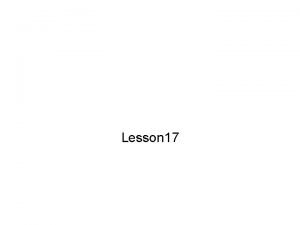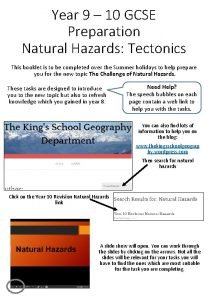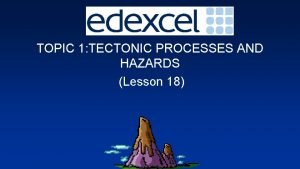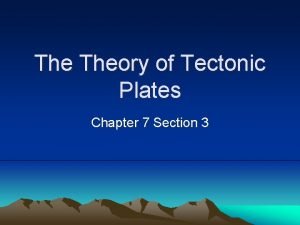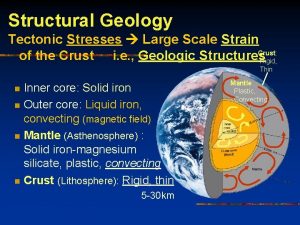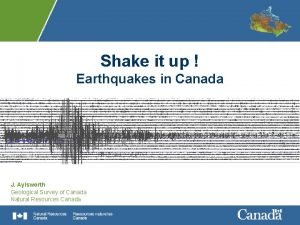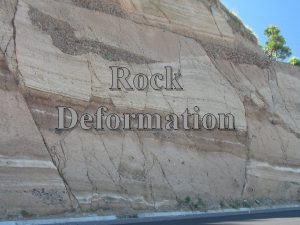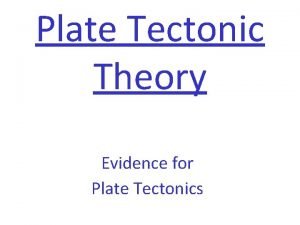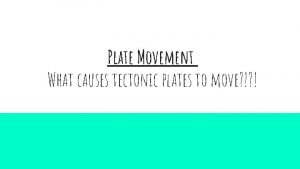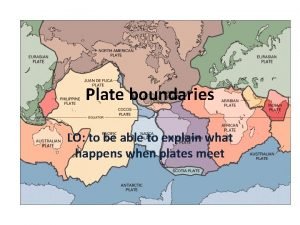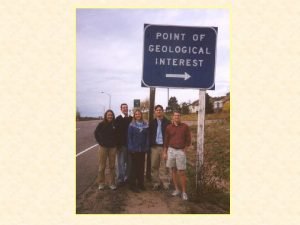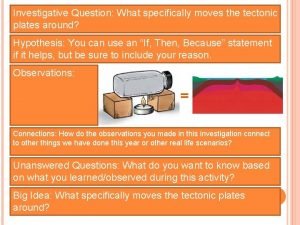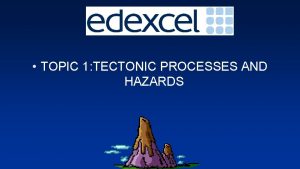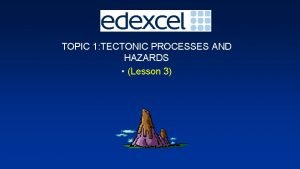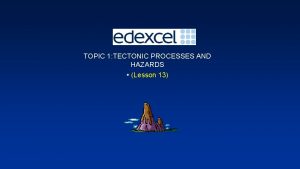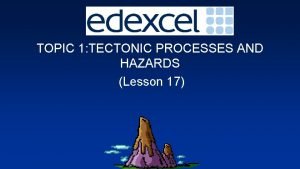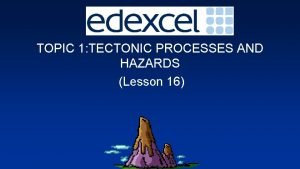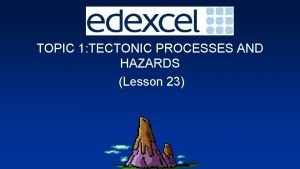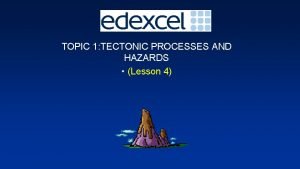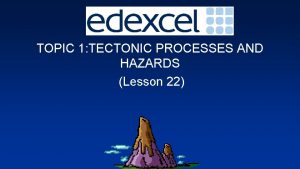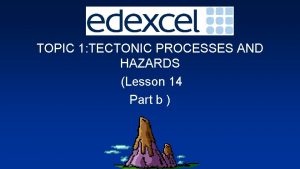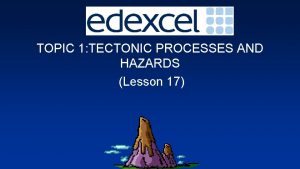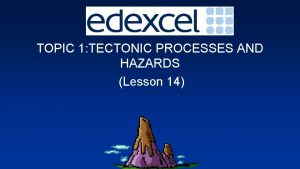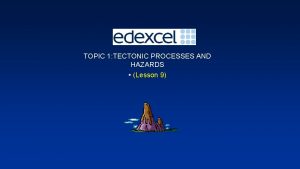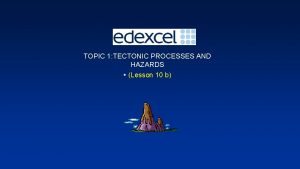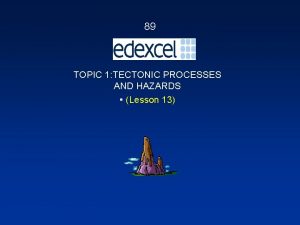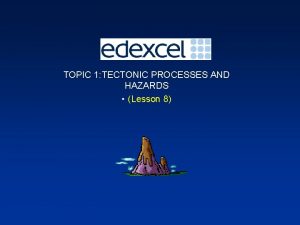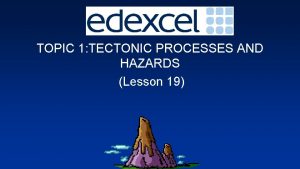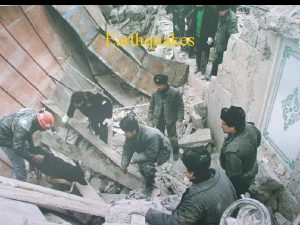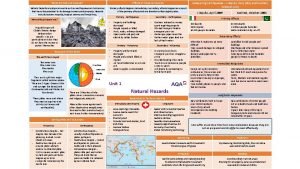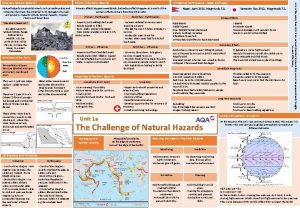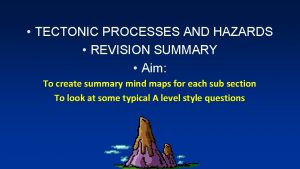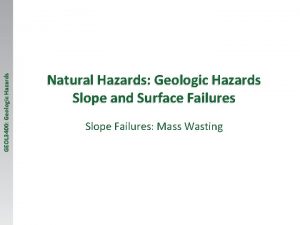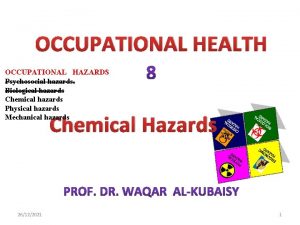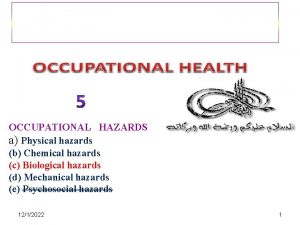TOPIC 1 TECTONIC PROCESSES AND HAZARDS Lesson 24

























- Slides: 25

TOPIC 1: TECTONIC PROCESSES AND HAZARDS (Lesson 24)

ENQUIRY QUESTION 3: • How successful is the management of tectonic hazards and disasters?

Last lesson’s objectives: • To understand the Hazard management Cycle • To understand Park’s Model (Disaster Response Curve) and be able to relate it to hazard examples , comparing different levels of response based on levels of development

The Hazard Management Cycle

Park’s Response model

Park’s Response Model (Disaster response Curve)


WHITEBOARD WAKE UP QUESTIONS! • Name three warning signs prior to a volcanic eruption? • INCREASE IN MINOR EXTRUSIVE ACTIVITY, INCREASE IN VOLCANIC GASES, INCREASE IN FREQUENCY AND SEVERITY OF PREVIOUS ERUPTIONS, INCREASE IN SEISMIC ACTIVITY • Name three methods of prediction • REMOTE SENSING, SEISMICITY, GEOPHYSICAL, HYDROLOGY, GAS, GROUND DEORMATION

Specification content • 1. 9 Tectonic hazard impacts can be MANAGED by a variety of mitigation and adaptation strategies, which vary in their effectiveness. • a) Strategies to modify the event include land-use zoning, hazard-resistant design and engineering defences as well as diversion of lava flows. • b) Strategies to modify vulnerability and resilience include hi- tech monitoring, prediction, education, community preparedness and adaptation. • c) Strategies to modify loss include emergency, short and longer term aid and insurance and the actions of affected communities themselves.

‘Managing The impacts of Tectonic Hazards’….

Today’s lesson objectives: To understand the different strategies involved with regard to managing tectonic hazard events: 1) Strategies used to modify the actual tectonic event itself 2) Strategies used to modify vulnerability and resilience of communities involved 3) Strategies used to modify losses incurred by the tectonic event To understand that the strategies involved will depend on a number of factors including a country’s level of development and amount of available resources

WHITEBOARD PAIRED THINKING • What do you think is meant by the following key terms? • HAZARD MITIGATION • and • HAZARD ADAPTATION?

MANAGING THE IMPACTS OF TECTONIC HAZARDS (p. 71) • HAZARD MITIGATION: Strategies meant to avoid, delay or prevent hazard events ( e. g. land use zoning, diverting lava flows, GIS mapping and hazard resistant design and engineering) • Whereas…. • HAZARD ADAPTATION: Strategies designed to reduce the impacts of hazard events ( e. g high- tech monitoring, crisis mapping, modelling hazard impacts, public education and community preparedness)

Some say that: ‘PREPARATION IS KEY’…

WHITEBOARD PAIRED THINKING • What factors will influence the response to tectonic hazards and disasters? • ( Clue think physical AND human…) • 5 mins

Factors affecting responses to hazards ( find a ‘notes’ page such as on p. 70) • The nature of the hazard itself – scale, impact, magnitude, frequency • • The quality of emergency organisations in the immediate aftermath The range/viability of recovery strategies The ability to reconstruct after the event The possibility/probability of a disaster-free period

Factors affecting responses to hazards cont. . Physical: accessibility • topography • climate Human: population density • degree of preparedness, including quality of existing infrastructure • technology and education levels available • economic wealth • Government will, and competence (governance) • Culture?

WHITEBOARD PAIRED THINKING • Who are considered to be ‘ The Players’ ( i. e the people involved in making geographical decisions) within Management of Tectonic hazards and disasters? • 2 mins

Who are ‘The Players’? • • Individuals Local groups of people – the local community Local/regional government (eg rescue services) National government (eg civil protection and defence ) International bodies: voluntary - eg charities ( Oxfam etc) non-voluntary – eg other governments A U. S. soldier waits for order before distributing food aid.

Possible Tectonic Management Strategies 1. Modify the event ( i. e. reducing the risk of damage) – ability to control, avoid, resist - involves engineering and technologies 2. Modify vulnerability/the risk – eg prediction, warning, preparedness, education 3. Modify the loss – eg aid; insurance cover • Let’s continue to examine some actual events, bearing in mind these elements…. .

GOVERNMENT HAZARD MITIGATION STRATEGIES p. 71 • 1. Land use zoning (Modifying the risk) • • • This is a process by which local government planners regulate how land in a community may be used ( e. g. as residential, industrial or recreational). In areas at risk from volcanic eruptions and tsunamis, land use zoning is an effective way to protect both people and property. Land use planners and others use Hazard maps like these to help make decisions about the appropriate use of land in each zone as well as for preparatory tasks such as creating safe evacuation routes. (Cont. booklet p. 79…. )

Case study: Soufriere Hills volcano eruptions, Montserrat, Caribbean 1995 and 1997

Land Use Zoning: e. g Montserrat, Caribbean July 1995 the Soufriere Hills volcano erupted for the first time in 350 years. One month later, 50% of the population had been evacuated to the north away from the danger zone. Over time the eruptions became even more explosive and more people were evacuated. In 1997 another explosion destroyed villages in the centre of the island. Of the island’s 40 sq ml. only 15 sq ml were considered safe.

• Fig. 3 shows the impact of the eruptions on the island. Those people who have stayed on are experiencing very harsh conditions. The south of the island was the most developed, with the main towns, communications and services. The north had few roads and settlements. Makeshift shelters are used with inadequate sanitation. The country now relies on aid from London. • After the eruption and evacuation, people called for the British government to pay compensation and to rebuild the island. Aid totalling £ 41 m has been offered with £ 10. 5 m to relocate refugees. In 1997, £ 2400 was offered to each adult over 18 wanting to leave the island. The Montserratians wanted £ 20000 person. • Does it really make sense to rebuild after what the island has experienced?

2. Diverting Lava Flows (‘Modifying the Event’reducing the risk of damage ) • • Historically , different methods have been attempted to divert lava flows away from people and communities. These methods have included building barriers and digging channels to try to divert the flows into safer directions. While these methods have had some successes ( e. g. 1993 Mount Etna, Sicily. Italy)in general they have been fairly ineffective…. .
 Concurrent in os
Concurrent in os Clincher examples
Clincher examples Broad and specific topic examples
Broad and specific topic examples Energy in earth processes topic 5
Energy in earth processes topic 5 Lesson 17: patterns and processes of evolution
Lesson 17: patterns and processes of evolution Patterns of evolution
Patterns of evolution Lesson 17 patterns and processes of evolution
Lesson 17 patterns and processes of evolution Primary and secondary effects of a tectonic hazard
Primary and secondary effects of a tectonic hazard Primary and secondary effects of a tectonic hazard
Primary and secondary effects of a tectonic hazard Mariana trench tectonic plates
Mariana trench tectonic plates Tectonic hazard profile
Tectonic hazard profile Convergent boundary divergent boundary transform boundary
Convergent boundary divergent boundary transform boundary What is the main cause of tectonic plate movement
What is the main cause of tectonic plate movement Tectonic joints
Tectonic joints Tectonic joints
Tectonic joints Grand banks earthquake of 1929
Grand banks earthquake of 1929 Synformal anticline
Synformal anticline Evidence for pangea
Evidence for pangea Continental drift vs plate tectonics
Continental drift vs plate tectonics What causes tectonic plates to move? *
What causes tectonic plates to move? * Constructive plate boundary
Constructive plate boundary Oreo plate tectonics
Oreo plate tectonics Fuji plate
Fuji plate What is the border between two tectonic plates called
What is the border between two tectonic plates called Tectonic plates with names
Tectonic plates with names Example of an investigative question
Example of an investigative question






